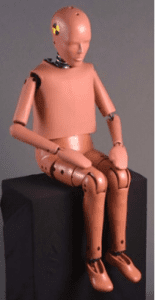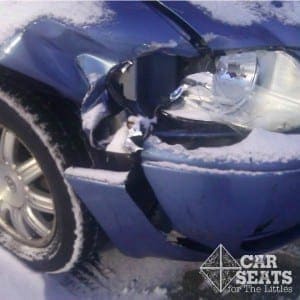Accidents, crashes, collisions: by any name, they’re what we’re all hoping to avoid but preparing to survive. Vehicle crashes are violent, unpredictable, and complex. An enormous amount of effort goes into designing the different technologies that protect people riding in cars in the case of a collision.
To understand how car seat engineers design their products, let’s look at the simplest elements of crash dynamics. We always remind our readers that it’s essential that every child be in the correct, properly used seat for their age and size; crash dynamics help illustrate why those factors are so important.
Three Crashes in a Collision
The First Crash: Vehicles
The first crash is the one that we are the most familiar with, and the one we’re trying to avoid — when the vehicle crashes into another vehicle or object.
It happens in a flash: your car goes from driving to impacting the car in front of you, or a deer, or a tree, or an unsuspecting kangaroo. As the vehicle crashes into something, it stops or slows very abruptly, and at the point of impact the car’s structure will bend or break. That crumpling action works to absorb some of the initial crash forces, protecting the passenger compartment to some degree.
This video is from the CPST Curriculum. It clearly shows these stages and how they impact the passengers.
The Second Crash: Passengers
When traveling at speed, the vehicle and the passengers move at the same rate. When the vehicle collides with something and comes to an abrupt stop, the passengers also have to slow from their speed in motion to zero in a hurry.
Here’s where our vehicle seat belts and child restraints come in. If they weren’t holding us in place the only thing that would stop our motion toward the impact is the windshield, or, in the case of the back seat passenger without a seat belt, the person in front of us.
As the vehicle comes to a stop, people will collide with what is in front of them: the steering wheel, the front seat, the dashboard. This is the second crash — where the passengers in the vehicle collide with the interior of the car itself.
The Third Crash: Internal Organs
Just as we are moving inside the car when the car stops, our organs are moving inside our bodies as our bodies stop. By the magic of inertia, as we come to a complete stop our brains, our bladders, our intestines, and all of the other good stuff inside our bodies also have to come to a stop. To stop them, there is one final crash, the one where the body parts smash into each other as they halt. When that happens, it can cause serious injuries: a concussion, for example, is often the result of the brain hitting the skull. Unfortunately severe accidents cause major internal injuries because all parts of our bodies have to come to a complete stop.
How Car Seats and Booster Seats Help
Car seats and booster seats work to minimize crash forces to children in a lot of different, crucial ways. They work to absorb crash forces (instead of the child’s body absorbing those same forces), help children’s bodies safely come to a stop (we call this the “ride down” of the crash forces), spread enormous crash forces over a larger part of the body, keep children with the vehicle, and keep passengers’ heads from contacting hard parts of the vehicle — protecting the head, brain, and spinal cord.
While car seats, booster seats, and seat belts don’t prevent crashes, they are critical to reducing the severity of injury to vehicle occupants involved in a collision. Every passenger’s chance of survival increases dramatically when appropriately restrained. By keeping children in the appropriate type of restraint for as long as possible, their chances of surviving a crash are also increased.
Vehicle seat belts, booster seats, and car seats all have a common goal: that the occupants of cars survive these three crashes with minimal injury. When they are used properly, car seats can greatly increase children’s chances of survival.
This material is covered in the CPST course. It’s on our minds as we help caregivers select and install the right car seat or booster seat.


